22 Interesting & Important Facts About The Weather You Should Know
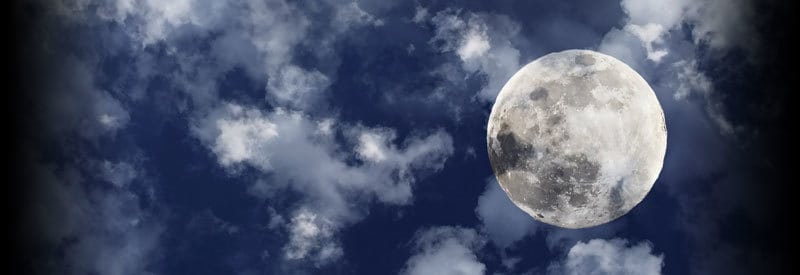
As much as you already know about the weather and climate, there are still a few interesting and important facts about the weather that you should be aware of.
After years or even decades of closely following weather reports and discussing them with friends & family, you may already have a good grasp of how its general behavior and the atmospheric conditions that characterize it.
Unfortunately, there are quite a few myths and misconceptions that stubbornly keep doing the rounds in modern culture, as well as some essential weather facts that don't get emphasized enough. We address a few of these important facts in the following list.
22 Interesting & Important Facts About The Weather
The following list describes some interesting as well as crucial facts about the weather that you may already know, while others might be misconceptions or myths that are so widely accepted that you will be surprised to learn the truth.
After listing all 22 facts, we will take a close look at each individual one to get a better understanding of what it means as well as its possible implications:
- 1Weather Is Unpredictable, Always
- 2Climate Is What You Expect, Weather Is What You Get
- 3Wind Blows From Areas Of High To Low Pressure
- 4Commonwealth Bay, Antarctica, Is The Windiest Place In The world
- 5Lightning Can Strike Twice
- 6The Entire Length Of The Mississippi River Froze Over In 1899
- 7Hurricanes And Typhoons Are The Same Types Of Storm
- 8Mawsynram, India, has the highest rainfall on the planet.
- 9The Average Speed Of A Raindrop Is 9 Meters (29.6 feet) Per Second
- 10One Billion Tons of Rain Falls On The Planet Every Minute
- 11Lightning Strikes The Earth's Surface 100 Times Per Second
- 12Snowflakes Can Take Up To An Hour To Reach The Earth
- 13Ozone Is Hazardous For Your Health
- 14Tornadoes And Waterspouts Are The Same Weather Phenomena
- 15Antarctica Is Completely Covered By A Glacier
- 16Why Hurricanes Have Female Names
- 17The Air Is 78 Percent Nitrogen
- 18Antarctica Is The Largest Desert In The World
- 19A Raindrop Is Not Tear-Shaped
- 20The highest temperature ever recorded was in Death Valley, USA
- 21A Warm Front Can Cause Rain
- 22Never Drive Through Flood Water
1) Weather Is Unpredictable, Always

This statement is no criticism of any weather service or meteorologist. Weather forecasts have become remarkably accurate over the last few decades, with weather sensors spread out over the Earth's surface, the oceans, atmosphere, and in space.
A wealth of historical weather and climate data, combined with advanced forecasting models, makes modern-day weather predictions very reliable.
But as we all know, sometimes the weather turns out completely the opposite as was predicted. It usually is no fault of any meteorological service, but simply due to the fact that there are just too many atmospheric variables that can change in a short space of time.
For example, on the coast, the ocean or land temperatures can rise or drop quicker or slower than expected. Ocean currents can unexpectedly change and dramatically influence the weather. Jet streams in the upper atmosphere can slightly shift and have a large impact.
These are just a few examples of the large number of variables in the atmosphere that can come into play and influence the weather unexpectedly and quickly.
2) Climate Is What You Expect, Weather Is What You Get
This statement is basically the very definition of the primary difference between the weather and climate. (It is very easy to confuse the two, which often lead to many misunderstandings and debate.)
Climate is the average weather conditions that are expected during a specific part of the year or season, calculated over a period of at least 30 years. Weather, on the other hand, is the specific atmospheric conditions at a particular location at any given time.
For example, the climate may dictate that a day in the middle of summer will be warm and sunny. On one particular summer's day, though, the weather can be cloudy & rainy, with temperatures dropping below 15° Celsius (59° Fahrenheit).
Read more about the difference between weather and climate in this article.
3) Wind Blows From Areas Of High To Low Pressure
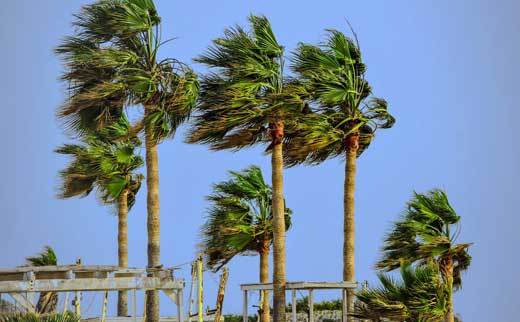
Low and high-pressure systems are what creates the majority of winds, and it always flows from an area of high to low pressure.
The best way to describe it is to use the analogy of a party balloon. As you blow it up, air fills the balloon, and the pressure inside also starts to build. When it is fully inflated, the air pressure inside the balloon is much higher than that on the outside.
As soon as you open a hole in the balloon, the air immediately rushes out to equalize the pressure inside and outside. Wind acts exactly the same way as it flows from a high-pressure to low-pressure region.
4) Commonwealth Bay, Antarctica, Is The Windiest Place In The world
The windiest place in the world is also one of the coldest. With winds reaching an average annual wind speed of 80 km/h (50 mph), Commonwealth Bay in Antarctica holds the record for the windiest location on the planet.
Wind gusts also regularly exceed 241 km/h (150 mph) in this region, and the windiest hour here was recorded on 6 July 1930 at Cape Denison with a speed of 153 km/h (95 mph).
You can read more about the windiest places on the planet in this article.
5) Lightning Can Strike Twice
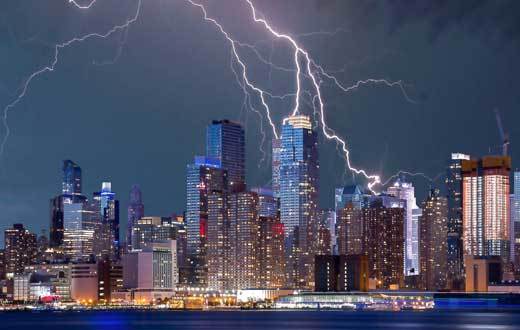
One of the most common and dangerous myths is that lightning does not strike the same area twice in one thunderstorm. This misconception most probably arose out of reassuring someone that a negative or dramatic event in their life will not occur again.
Whatever the reason, the fact remains that lightning can and most probably will strike the same location more than once. If it does not happen during the same thunderstorm, it can happen during an upcoming one.
There is just no scientific evidence whatsoever to support this myth. You can read more about lightning, how it forms, and its characteristics in this article.
6) The Entire Length Of The Mississippi River Froze Over In 1899
The southern state of Louisiana in the United States is not exactly known for its freezing cold winters or icy conditions. However, this all changed in February 1899.
New Orleans experienced 3-4 inches of snow during this period. But that was just the beginning. The entire length of the Mississippi River froze over all the way to the Gulf of Mexico and even extended partially into the Gulf.
This may have been a freak occurrence or once-off, but don't be too surprised if something similar happens in the near future as Climate Change is wreaking havoc across the world.
7) Hurricanes And Typhoons Are The Same Types Of Storm
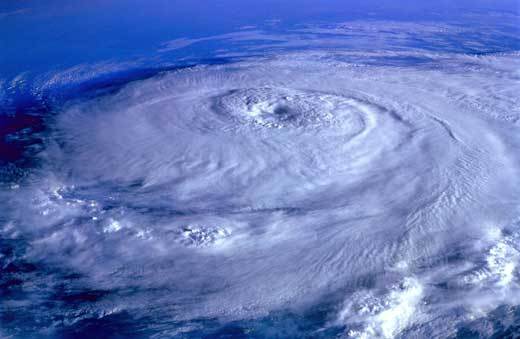
You may be getting confused when meteorologists talk about hurricanes, typhoons, and cyclones during forecasts, but each time you see the same type of phenomenon on the satellite image.
Well, your eyes are not deceiving you since hurricanes, typhoons, and cyclones, are all tropical storms that originate in the warm waters of the Subtropics. They form in the same way and have exactly the same characteristics.
The only real difference between these weather phenomena is the location on the planet where they occur:
- 1The term "hurricane" is used when the storm occurs in the Central & Eastern North Pacific, as well as the North Atlantic.
- 2The term "typhoon" is used when it occurs in the Northwest Pacific.
- 3The term "tropical cyclone" is used when the storm occurs in the South Pacific and the Indian Ocean.
8) Mawsynram, India, has the highest rainfall on the planet.
Although many regions around the world occasionally experience periods of heavy rains or sometimes even microbursts, there are a few locations whose average annual rainfall is so high that it almost defies belief.
Mawsynram, a small village in the district of Meghalaya, India, is the rainiest place in the world, with an average annual rainfall of 11 871 mm (467 inches).
You can find the list of the 12 rainiest cities/towns in the world in this article.
9) The Average Speed Of A Raindrop Is 9 Meters (29.6 feet) Per Second
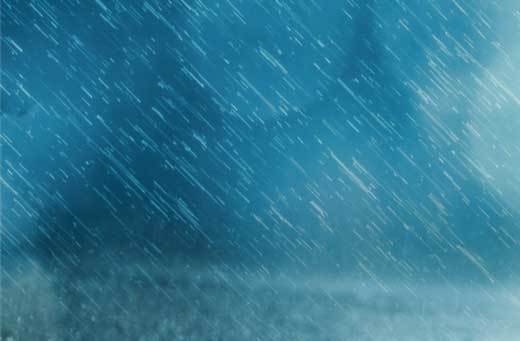
Different types of precipitation fall at different speeds towards the ground, depending on size, density, and weight. For example, a snowflake falls slower than a raindrop, which in turn falls slower than larger hailstones.
Raindrops, the most common type of precipitation, fall at an average speed of 9 meters (29.6 feet) per second or approximately 20 mph.
10) One Billion Tons of Rain Falls On The Planet Every Minute
In the two previous points, we discussed various aspects of rainfall, including the naming of the rainiest place in the world. Therefore it should come as no surprise that a lot of rain falls on the planet's surface every day.
What might be surprising, though, is precisely how much rain actually falls. Every minute, one billion tons of rain reaches the planet's surface.
11) Lightning Strikes The Earth's Surface 100 Times Per Second
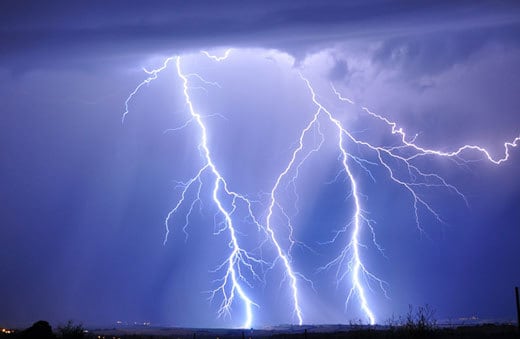
At an earlier point, we debunked the myth that lightning cannot strike the same place twice during a storm. Add to the fact that it can heat the air to 27 700° Celsius (50 000° Fahrenheit) and generate up to 1 billion volts of electricity, and you understand the danger.
But what can really be startling is the fact that the Earth's surface gets struck by a lightning bolt 100 times every second.
12) Snowflakes Can Take Up To An Hour To Reach The Earth
From all the different types of precipitation, snowflakes take the longest to reach the Earth's surface. It is not uncommon to observe it almost floating in the air or being blown around by a gentle breeze.
In Fact, depending on atmospheric conditions, it can snowflakes up to an hour to reach the planet's surface.
13) Ozone Is Hazardous For Your Health

Even readers who know just a small amount about the weather and recent climate history most probably heard about the hole in the ozone layer and how vital this gas is for our survival on this planet.
Situated about 15-30 km (9-18 miles) above the planet, ozone is responsible for absorbing the vast majority of dangerous ultraviolet (UV) rays that enter Earth's atmosphere. Without it, life on Earth will not be possible.
The gas itself is toxic and can be deadly if any human comes in direct contact with it. If inhaled, ozone can lead to severe respiratory conditions and damage the lungs.
14) Tornadoes And Waterspouts Are The Same Weather Phenomena
Although they are given different names, tornadoes and waterspouts are essentially the same weather phenomena. Both occur as a result of a column of fast rotating air that is strong enough to lift objects on the surface into the air.
In the case of a tornado, not only soil and vegetation but also solid objects like building debris and other manmade objects are picked up and tossed around, which makes them so dangerous and visually intimidating.
Waterspouts, on the other hand, are very seldom seen since they mostly occur over water. As they only pick up surface water, the amount of damage they can cause is also much less than that of a tornado over land.
As a result of the different levels of dangers involved, combined with most observers' familiarity with tornadoes, it is easy to assume that the two occurrences are entirely different weather phenomena.
15) Antarctica Is Completely Covered By A Glacier
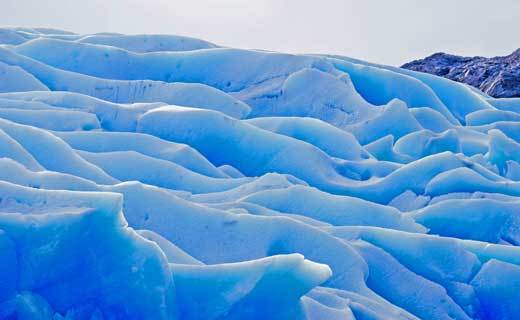
It may be hard to believe that a single glacier entirely covers a continent with a surface area of 14.2 million square kilometers (5.5 million square miles). However, Antarctica is completely covered by a continental glacier.
A continental glacier should not be confused with the more recognizable valley glaciers most readers are familiar with. You can find out what continental glaciers are and how they form in this article.
16) Why Hurricanes Have Female Names
In 1950 the United States National Hurricane Center initiated a system for using the phonetic alphabet to name hurricanes and tropical storms after realizing that human names are easier to remember than latitude-longitude coordinates.
In 1953 the National Weather Service revised the system to naming hurricanes after women to avoid repetitive naming. To avoid possible claims of sexism and discrimination, the system was changed again in 1978 to include both male and female names.
The practice of using female names dates back centuries and is rooted in maritime customs. In ancient times, sailors used to dedicate ships to goddesses, and in recent centuries, vessels were seen as mother figures by ships' captains and mariners.
You can get more in-depth information describing the past and present use of hurricane names in this article.
17) The Air Is 78 Percent Nitrogen
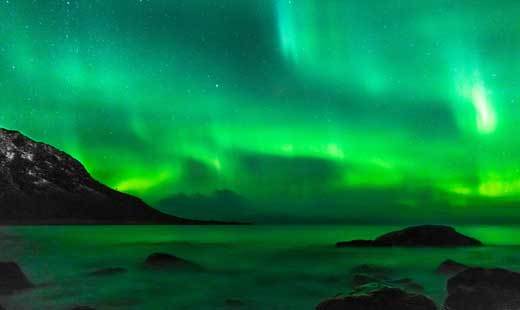
Since all living organisms (except a small aquatic parasite called Henneguya salminicolathat) need oxygen to survive, it is only logical and understandable to think that the air we breathe mostly consists out of oxygen.
Surprisingly, though, only 21 percent of the air in the troposphere* is made up out of oxygen. The vast majority of the air we breathe consists out of nitrogen, which makes up 78 percent of the air in the atmosphere.
*The lowest layer of the atmosphere in which all life exists.
18) Antarctica Is The Largest Desert In The World
With a surface area of 14.2 million square kilometers (5.5 million square miles), Antarctica is the largest desert in the world.
This fact will definitely come as a surprise to most readers since it is hard to imagine a continent entirely covered by ice to be seen as a desert.
However, a desert is defined by the amount of rainfall it receives, which must be less than 250 mm (15.26 inches) per year to be considered a desert. With an annual rainfall of less than 200 mm (7.87 inches), Antarctica is the largest desert in the world.
If you are interested in finding out more about the desert climate and its characteristics, you can read about it in this article.
19) A Raindrop Is Not Tear-Shaped
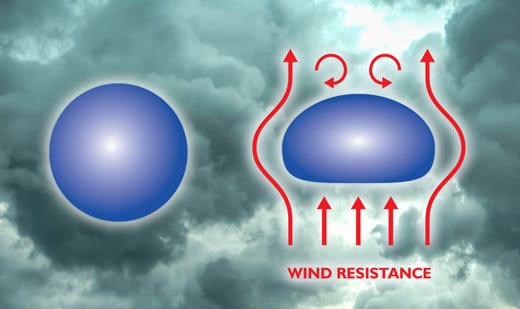
The popular tear-shaped form of a raindrop is so widely used that it is no surprise that it is commonly viewed as the real shape of rain as it forms in a cloud after condensation.
In reality, a raindrop is spherical (round) in shape when it first develops as microdroplets cling together after they collide to form larger drops. As it starts to fall to the ground, air resistance forces its bottom to flatten out before it eventually changes shape completely.
The teardrop shape of a water droplet comes from the form it takes as it flows down a surface like a window, a person's face, or a cold glass of liquid. Since most people see waterdrops in this form, they simply assume that this is the natural shape of rain.
Learn more about the shape of a raindrop in this article.
20) The highest temperature ever recorded was in Death Valley, USA
Locations around the world are recording record-high temperatures, especially in recent years, as Global Warming is causing a steady rise in warm weather around the planet.
However, the highest temperature ever recorded occurred in Death Valley, USA, on 10 July 1913 when the mercury rose to 56.7 °Celsius (134.1 °Fahrenheit).
21) A Warm Front Can Cause Rain
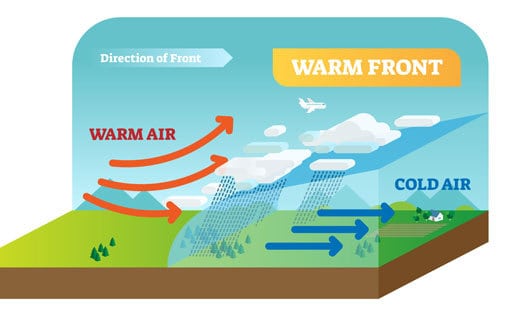
A common belief exists that a cold front is associated with cold and wet weather, while a warm front is more commonly associated with warm & dry weather.
One of the main reasons for this association is that a warm front is accompanied by a high-pressure system, which is characterized by warm and dry weather.
Although it doesn't produce the same stormy wet weather that abruptly arrives as a cold front moves in, a warm front does create a more gentle and sustained form of rainfall when enough moisture is present in the air.
The softer but persistent rain is a result of the gentle slope on which the warm air rises on the back of the preceding cold air.
To get a better understanding of how a warm front develops and how it differs from a cold front, you can read more about the differences between the two in this article.
22) Flood Water Are Deceptively Dangerous
Extreme weather phenomena such as hurricanes, monsoons, and microbursts can result in widespread flooding. (Flash flooding is one of the more dangerous types of flooding that can occur.)
Floodwaters, more often than not, appear much calmer and not as deep as they really are. It is one of the main reasons they get underestimated so often, and many people get in trouble or even lose their lives as a result.
A flooded road is especially dangerous, and one should never attempt to cross it. Not only can it be much deeper than expected and wash a vehicle away, but it may also hide dangerous obstacles just below the surface.
Flooded streams and rivers are just as dangerous to try and cross. They may appear relatively shallow and slow-moving, but it takes a depth of less than waist-high to wash you or your vehicle away.
In fact, a fast-moving stream only needs to be 152 millimeters (6 inches) in depth to knock a person off his/her feet and 0.61 meters (2 feet) deep to wash a vehicle away.
Conclusion
In this article, we highlighted a wide variety of facts about the weather. Some are interesting and surprising, while others may be alarming but important to know.
These are just a few of the countless and interesting facts around meteorology. If you are interested in more, the articles below add more fascinating facts, as well as addressing some of the common misconceptions surrounding atmospheric conditions.
Never miss out again when another interesting and helpful article is released and stay updated, while also receiving helpful tips & information by simply clicking on this link .
Until next time, keep your eye on the weather!
